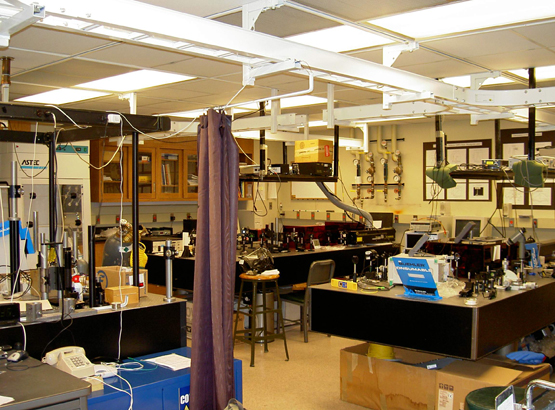
Integrated Optics Laboratory 1327 EECS
Current Projects
- Astronomical Search for Planetary Systems: Integrated Optics for Space Interferometers (with Prof. Monnier, UM Dept. of Astronomy)
- General References:
- Breckinridge et al., “Astronomical Search for Origins,” Optics and Photonics News , vol. 16, pp. 25-29, Feb. 2005 (see the section on Terrestrial Planet Finder (TPF)).
- T. Appenzeller, “Someplace Like Earth,” National Geographic , pp. 68-95, Dec. 2004.
- E. Laurent et al., “Integrated Optics for Astronomical Interferometery,” Astronomy and Astrophysics , vol. 390, pp. 1171-1176, 2002.
- Active Integrated Optic Resonant Optical Gyroscope (see figure below)
- General References:
- John Dakin and Brian Culshaw eds., Optical Fiber Sensors , vol. 4, chapter 11, Artech House, Boston, 1997.
- B. J. Thompson ed., Selected Papers on Fiber Optic Gyroscopes,SPIE Milestone Series , vol. MS 8, SPIE 1989.
- William K. Burns ed., “Optical Fiber Rotation Sensing,” Academic Press, San Diego, 1994.
- Quantum Information Theory and Communications
- General References:
- M. A, Nielsen and I. L. Chuang, Quantum Computation and Quantum Information , Cambridge University Press, Cambridge , UK , 2000.
- http://www.theory.caltech.edu/%7Epreskill/ph219/
- Ion Exchange Modeling in Glass:
- General References
- S. Iraj Najafi ed., Introduction to Glass Integrated Optics, Artech House, Boston, 1992.
- Femtosecond Direct Writing of Novel Waveguide Devices
- General Reference:
- S. Nolte et al., “Femtosecond Waveguide Writing: A New Avenue to Three-Dimensional Integrated Optics,” Appl. Phys. A., vol. 77, pp. 109-111, 2003.
- Photonic Crystal Waveguides
- General References:
- http://physicsweb.org/articles/world/13/8/9/1
- J. D. Joannopoulos, R. D. Meade, and J. N. Winn, Photonic Crystals – Molding the Flow of Light, Princeton University Press, Princeton, NJ, 1995.
- S. G. Johnson and J. D. Joannopoulos, Photonic Crystals – The Road From Theory to Practice , Kluwer Academic Publishers, Boston, 2002.
- K. Sakoda, Optical Properties of Photonic Crystals , Springer, Berlin , 2001.


Ring Resonator: (a) 1.6 cm diameter ring waveguide resonator in glass (b) spectral response
Summary of Earlier Projects
In 1988 Professor Winick joined the Department of Electrical Engineering and Computer Science at the University of Michigan and established an experimental and theoretical program in glass/crystal integrated optics. His research at the University has evolved along two distinct lines of inquiry, integrated optics and information theory/coding. A common goal of these parallel efforts has been the development of new devices and techniques for advanced optical communication systems, both fiber-based and free-space. Professor Winick’s arrival at the University coincided with a remarkable growth period in the optical communications industry driven by the demands of the internet. This growth created significant research opportunities for those working to develop new miniaturized optical components (i.e., integrated optics). At the University of Michigan , his research has spanned many aspects of this field and has involved the design, modeling, fabrication and characterization of a large variety of new integrated optical devices. In particular, he made significant research contributions in the areas of waveguide filter design, rare earth-doped waveguide lasers and amplifiers, passive glass waveguide devices, and new waveguide fabrication techniques. Some highlights of these efforts include the first use of exact inverse scattering techniques to design dispersion compensators, the first demonstration of a distributed Bragg reflector (DBR) glass waveguide laser, the first demonstration of an erbium:ytterbium co-doped glass waveguide laser (simultaneously with two other international teams), and the first use of femtosecond laser writing to fabricate active and complex passive integrated optical devices. His recent work, done in collaboration with Translume, Inc., on the application of femtosecond lasers to write waveguides directly inside the bulk of transparent dielectrics has also become an area of considerable international research interest.
In addition to his work in optics, Professor Winick has tackled both theoretical and applied problems in information theory and communications. In particular, in the theoretical arena, he has extended the class of channels for which the error exponent is known exactly and has constructed codes that achieve the error exponent for this channel class at all rates less than capacity. He has also developed bounds on the minimum distance of runlength-limited (RLL) constrained codes. These bounds can be used to study the error-correcting capability of RLL-codes. On the applied side, Professor Winick has recently developed modulation, coding and decoding schemes for AWGN, bandwidth-constrained channels that come close to achieving capacity. A combination of sophisticated techniques, including LDPC codes, multi-level coding, iterative multi-stage decoding, and trellis-shaping, are used to achieve performance within 0.8 dB of capacity. Finally, Professor Winick has recently studied the use of LDPC codes, together with joint iterative decoding and channel state estimation, for a channel (block interference) that has memory. In addition to analyzing performance, error exponents for such a channel when the code is constrained to be LDPC were derived.
